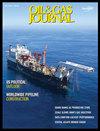金枪鱼油田,吉普斯兰最近开发的一个项目
IF 0.1
4区 工程技术
引用次数: 4
摘要
位于澳大利亚吉普斯兰盆地的Tuna油田于1982年成功完工,是埃索公司在该地区开发的最复杂的油田。在上白垩统至始新统拉特罗布群断陷部分侵蚀背斜闭包中,有4套储层。其中一些储层直到钻井开发阶段才被发现,导致最初的开发计划发生重大变化,特别是在13口井中安装了多口完井。使用的完井类型有单、串联、双、双/串联。本文章由计算机程序翻译,如有差异,请以英文原文为准。
Tuna field, a recent Gippsland development
Successfully completed in 1982, the Tuna field in Australia's Gippsland basin was the most complex of the fields developed by Esso in that area. The commercial oil and gas reserves are contained in four sets of reservoirs in the Upper Cretaceous to Eocene Latrobe group sediments in a faulted and partly eroded anticlinal closure. Some of these reservoirs were not discovered until the development phase of drilling, causing significant changes to the initial development plan, notably the installation of multiple completions in 13 wells. The types of completions used were single, tandem, dual, and dual/tandem.
求助全文
通过发布文献求助,成功后即可免费获取论文全文。
去求助
来源期刊

Oil & Gas Journal
ENERGY & FUELSENGINEERING, PETROLEUM-ENGINEERING, PETROLEUM
自引率
0.00%
发文量
0
审稿时长
2.7 months
 求助内容:
求助内容: 应助结果提醒方式:
应助结果提醒方式:


